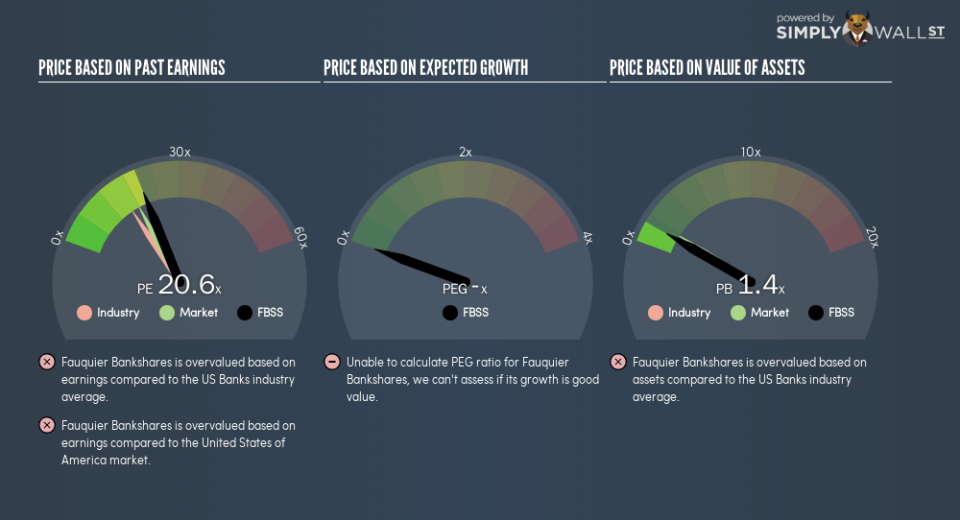Why Fauquier Bankshares Inc’s (NASDAQ:FBSS) High P/E Ratio Isn’t Necessarily A Bad Thing

This article is written for those who want to get better at using price to earnings ratios (P/E ratios). We’ll look at Fauquier Bankshares Inc’s (NASDAQ:FBSS) P/E ratio and reflect on what it tells us about the company’s share price. Fauquier Bankshares has a price to earnings ratio of 20.63, based on the last twelve months. In other words, at today’s prices, investors are paying $20.63 for every $1 in prior year profit.
Check out our latest analysis for Fauquier Bankshares
How Do You Calculate A P/E Ratio?
The formula for price to earnings is:
Price to Earnings Ratio = Price per Share ÷ Earnings per Share (EPS)
Or for Fauquier Bankshares:
P/E of 20.63 = $22 ÷ $1.07 (Based on the year to September 2018.)
Is A High Price-to-Earnings Ratio Good?
A higher P/E ratio implies that investors pay a higher price for the earning power of the business. That isn’t necessarily good or bad, but a high P/E implies relatively high expectations of what a company can achieve in the future.
How Growth Rates Impact P/E Ratios
Earnings growth rates have a big influence on P/E ratios. When earnings grow, the ‘E’ increases, over time. That means even if the current P/E is high, it will reduce over time if the share price stays flat. Then, a lower P/E should attract more buyers, pushing the share price up.
Fauquier Bankshares’s earnings per share grew by -4.3% in the last twelve months. And it has improved its earnings per share by 44% per year over the last three years. Unfortunately, earnings per share are down 7.3% a year, over 5 years.
How Does Fauquier Bankshares’s P/E Ratio Compare To Its Peers?
We can get an indication of market expectations by looking at the P/E ratio. You can see in the image below that the average P/E (15.7) for companies in the banks industry is lower than Fauquier Bankshares’s P/E.
Its relatively high P/E ratio indicates that Fauquier Bankshares shareholders think it will perform better than other companies in its industry classification. Shareholders are clearly optimistic, but the future is always uncertain. So investors should delve deeper. I like to check if company insiders have been buying or selling.
A Limitation: P/E Ratios Ignore Debt and Cash In The Bank
Don’t forget that the P/E ratio considers market capitalization. Thus, the metric does not reflect cash or debt held by the company. In theory, a company can lower its future P/E ratio by using cash or debt to invest in growth.
Such spending might be good or bad, overall, but the key point here is that you need to look at debt to understand the P/E ratio in context.
Fauquier Bankshares’s Balance Sheet
Fauquier Bankshares has net debt worth 21% of its market capitalization. This could bring some additional risk, and reduce the number of investment options for management; worth remembering if you compare its P/E to businesses without debt.
The Verdict On Fauquier Bankshares’s P/E Ratio
Fauquier Bankshares’s P/E is 20.6 which is above average (17.9) in the US market. With debt at prudent levels and improving earnings, it’s fair to say the market expects steady progress in the future.
Investors have an opportunity when market expectations about a stock are wrong. As value investor Benjamin Graham famously said, ‘In the short run, the market is a voting machine but in the long run, it is a weighing machine.’ Although we don’t have analyst forecasts, shareholders might want to examine this detailed historical graph of earnings, revenue and cash flow.
Of course you might be able to find a better stock than Fauquier Bankshares. So you may wish to see this free collection of other companies that have grown earnings strongly.
To help readers see past the short term volatility of the financial market, we aim to bring you a long-term focused research analysis purely driven by fundamental data. Note that our analysis does not factor in the latest price-sensitive company announcements.
The author is an independent contributor and at the time of publication had no position in the stocks mentioned. For errors that warrant correction please contact the editor at editorial-team@simplywallst.com.

